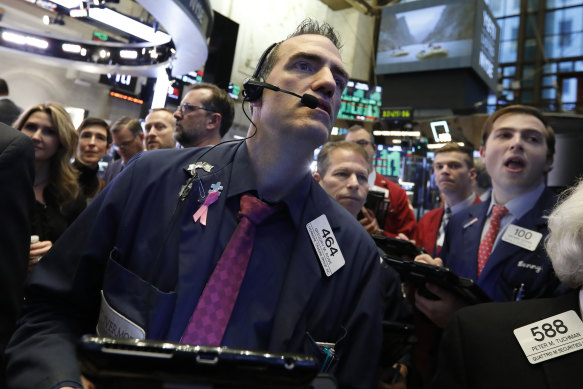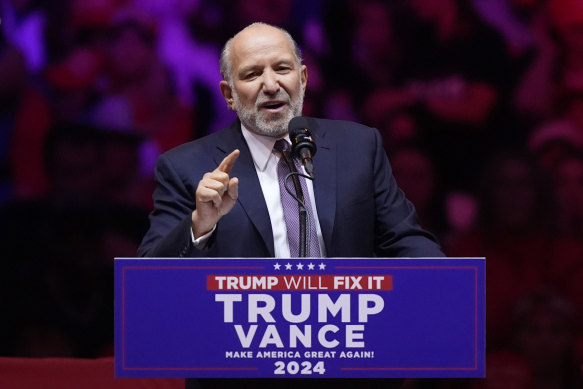
He’s also foreshadowed tariffs of up to 20 per cent on all imports and 60 per cent on imports from China.
He wants to round up, detain and deport 11 million or more illegal immigrants.
Somehow, Bessent needs to weave Trump’s plans, which would otherwise be highly inflationary and growth-destroying, into something that is coherent and won’t undermine growth or roil markets.

Wall Street welcomed the appointment of Bessent. Credit: AP
He has a plan. He calls it a 3/3/3 approach to economic policy. He wants to cut the budget deficit to 3 per cent of GDP, generate 3 per cent GDP growth and lift US oil production by 3 per cent.
Given that he likes Trump’s tax cuts, reducing the deficit would imply massive spending cuts, which, despite Elon Musk and Vivek Ramaswamy claiming their Department of Government Efficiency can cut $US2 trillion from $US6.75 trillion of annual government expenditures, looks improbable without gutting social security, Medicare, veterans, and homeland security.
Loading
With only slim congressional majorities, including some Republicans who will oppose cuts that impact their own electorates, cuts related to Joe Biden’s green initiatives-laden Inflation Reduction Act heavily favour Republican districts. Even if the administration were able to start the process now, it would probably take decades to stabilise the US government’s finances.
Bessent’s solution is familiar. If you can’t achieve his target of a budget deficit of 3 per cent of GDP via cuts to spending, then you need to boost the numerator – you need more growth and a larger economy. It used to be called supply-side economics.
The tax cuts would help, although Trump’s tariffs would effectively be a tax on consumers, falling disproportionately on middle- and lower-income households, which would depress growth and fuel inflation. The notion of cutting taxes for companies and the rich while raising them for ordinary Americans doesn’t seem to faze Republicans.
The 3 per cent growth in US GDP Bessent is targeting isn’t unprecedented.
Trump achieved that rate when the initial impact of the 2017 tax cuts hit the economy, ahead of the pandemic. Biden has done it for several quarters during his term. The current rate is 2.8 per cent. Over the past decade, however, real (after inflation) GDP has averaged less than 2 per cent per year.
Trump’s last administration bordered on dysfunctional but was able to curb Trump’s wildest ideas.
Lifting US oil production would probably help lower inflation, assuming that US oil producers, currently faced with a global oil glut, would keep drilling and pumping more into an environment of weak or falling oil prices. US oil production has hit record levels during the Biden administration.
Bessent’s positioning as a pro-growth deficit hawk is a key reason, apart from his CV (and the fact that Trump didn’t appoint another economically illiterate disruptor to the position), why Wall Street is keen on him. Institutional investors think he will be good for financial markets and be disciplined by the impact of the administration’s policies on them.
Steve Mnuchin, who held the US Treasury secretary role during Trump’s previous term – and was one of the few members of that cabinet that Trump didn’t sack – played a similar role in trying to be a moderating influence over some of the administration’s wilder policies. He came from a Wall Street background, too.
A key point of potential friction for Bessent, given that the administration will be full of China hawks, may be Trump’s trade policies.

Bessent beat fellow Wall Street billionaire Howard Lutnick for the role. Credit: AP
Trump sees tariffs as a multi-tool weapon to reduce the US trade deficit (because other countries are ripping the US off), as sanctions to coerce other countries into better trade deals or changing their economic structures or doing whatever the US wants, and as a revenue raiser (because he thinks they are paid for by exporters, rather than the importing companies and ultimately US consumers).
Even this week, he announced (on Truth Social) that he would impose a 25 per cent duty on goods from Mexico and Canada and an additional 10 per cent tariff on goods from China on his first day in office, blaming them for illegal imports of drugs, particularly fentanyl, and illegal immigrants crossing the Canadian and Mexican borders.
Bessent, from his public comments, sees tariffs as a one-time price adjustment and, therefore, not inflationary, but also as a useful tool for Trump’s foreign policy objectives. He’s broadly on the same page as Trump.
“Whether it’s getting allies to spend more on their own defence, opening foreign markets to US exports, security co-operation on ending illegal immigration and interdicting fentanyl trafficking or deterring military aggression, tariffs can play a central role,” he wrote recently in a Fox News article.
He has also said that he believes tariffs should be “layered in” gradually.
Loading
Whether Trump and, particularly when it comes to China, others in the administration are actually prepared to wield the tariff weapon in such a delicate fashion is an open question.
Trump’s last administration bordered on dysfunctional but was able to curb his wildest ideas. The incoming administration will have to deal with a less-restrained Trump, emboldened by this year’s victory, his hold on the Republican Party and the backing of the MAGA movement.
Wall Street might have confidence in Bessent’s ability to navigate internal politics and produce sensible economic and financial outcomes, but he does have some challenges ahead of him if he is to do so and, like Mnuchin, survive the next four years.
The Market Recap newsletter is a wrap of the day’s trading. Get it each weekday afternoon.









 Add Category
Add Category